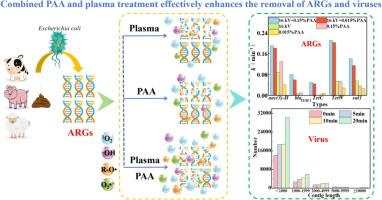Simultaneous elimination of antibiotic resistance gene and viruses in liquid manure by plasma/peracetic acid combination system
IF 8.1
1区 工程技术
Q1 ENGINEERING, CHEMICAL
引用次数: 0
Abstract
The widespread use of antibiotics in livestock farming has led to the accumulation of antibiotic resistance genes (ARGs) in farms and surrounding environments, with manure discharge accelerating their spread. However, effective techniques and mechanisms for removing ARGs from livestock liquid manure remain underexplored. This study examined the efficiency and mechanisms of combined plasma and peracetic acid (plasma+PAA) treatment for ARGs removal from liquid manure. Results show that plasma+PAA treatment significantly enhances ARGs removal efficiency, especially for the aac(3)-II gene, with removal rates increasing by 2.80-log and 1.55-log compared to plasma or PAA alone, with reaction rates improving by 116.6 % and 47.1 %, respectively. Singlet oxygen (1O2) was identified as the main reactive species driving the efficient removal of ARGs. The treatment also altered the microbial community, significantly reducing Escherichia, the primary ARGs host. Metagenomic analysis revealed that plasma+PAA suppressed genes related to bacterial physiology, including metabolic pathways and protein synthesis. This resulted in large-scale bacterial inactivation, making ARGs more vulnerable to removal by reactive species. Additionally, plasma+PAA treatment downregulated genes related to antimicrobial resistance, metal resistance, and virulence factors. The treatment also reduced the length and abundance of viral gene fragments. This study offers an effective strategy for controlling ARGs and viruses in livestock manure.

求助全文
约1分钟内获得全文
求助全文
来源期刊

Separation and Purification Technology
工程技术-工程:化工
CiteScore
14.00
自引率
12.80%
发文量
2347
审稿时长
43 days
期刊介绍:
Separation and Purification Technology is a premier journal committed to sharing innovative methods for separation and purification in chemical and environmental engineering, encompassing both homogeneous solutions and heterogeneous mixtures. Our scope includes the separation and/or purification of liquids, vapors, and gases, as well as carbon capture and separation techniques. However, it's important to note that methods solely intended for analytical purposes are not within the scope of the journal. Additionally, disciplines such as soil science, polymer science, and metallurgy fall outside the purview of Separation and Purification Technology. Join us in advancing the field of separation and purification methods for sustainable solutions in chemical and environmental engineering.
 求助内容:
求助内容: 应助结果提醒方式:
应助结果提醒方式:


